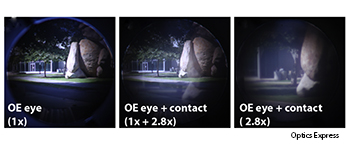
Images captured through the contact lens and mechanical model eye (left to right): model eye alone; eye and contact lens; and just the magnified outer portion of the lens.
Patients with age-related macular degeneration (AMD), a condition that damages the center of the eye’s retina, often need some sort of bulky or surgically implanted magnifying device to see details that the average person perceives easily. Researchers in the United States and Switzerland have developed the first type of contact lens that could enhance the vision of persons with AMD (Opt. Express 21, 15980).
The proof-of-concept lens developed at the University of California at San Diego was designed to magnify images and project them onto the remaining functional area of the retina outside of the fovea, which people without AMD use to read and see fine details.
The team, led by Eric Tremblay (now at the École Polytechnique Fédérale de Lausanne) built the lens out of polymethyl methacrylate (PMMA), with tiny grooves to reduce chromatic aberration. The center of the lens provides unmagnified vision, while a telescopic ring around the central region magnifies the image field.
With this type of lens design, the AMD sufferer would need to wear a modified pair of polarizing liquid-crystal glasses designed for use with 3-D television sets. The glasses would allow the wearer to switch between 1× and 2.8× magnifications.
The lens has a long way to go before it enters clinical use. For one thing, the lens is made from the type of hard contact lens material that fell out of favor 30 years ago because it keeps oxygen from reaching the eye’s conjunctiva and cornea. The scientists are experimenting with a design based on two layers of the polymers that go into modern “rigid gas-permeable” contacts. The dual-layer design might reduce the image degradation introduced by the achromatic grooves in the original version. The lens also needs to be tested on actual humans, instead of a small camera built into a life-sized model of a human eye.
